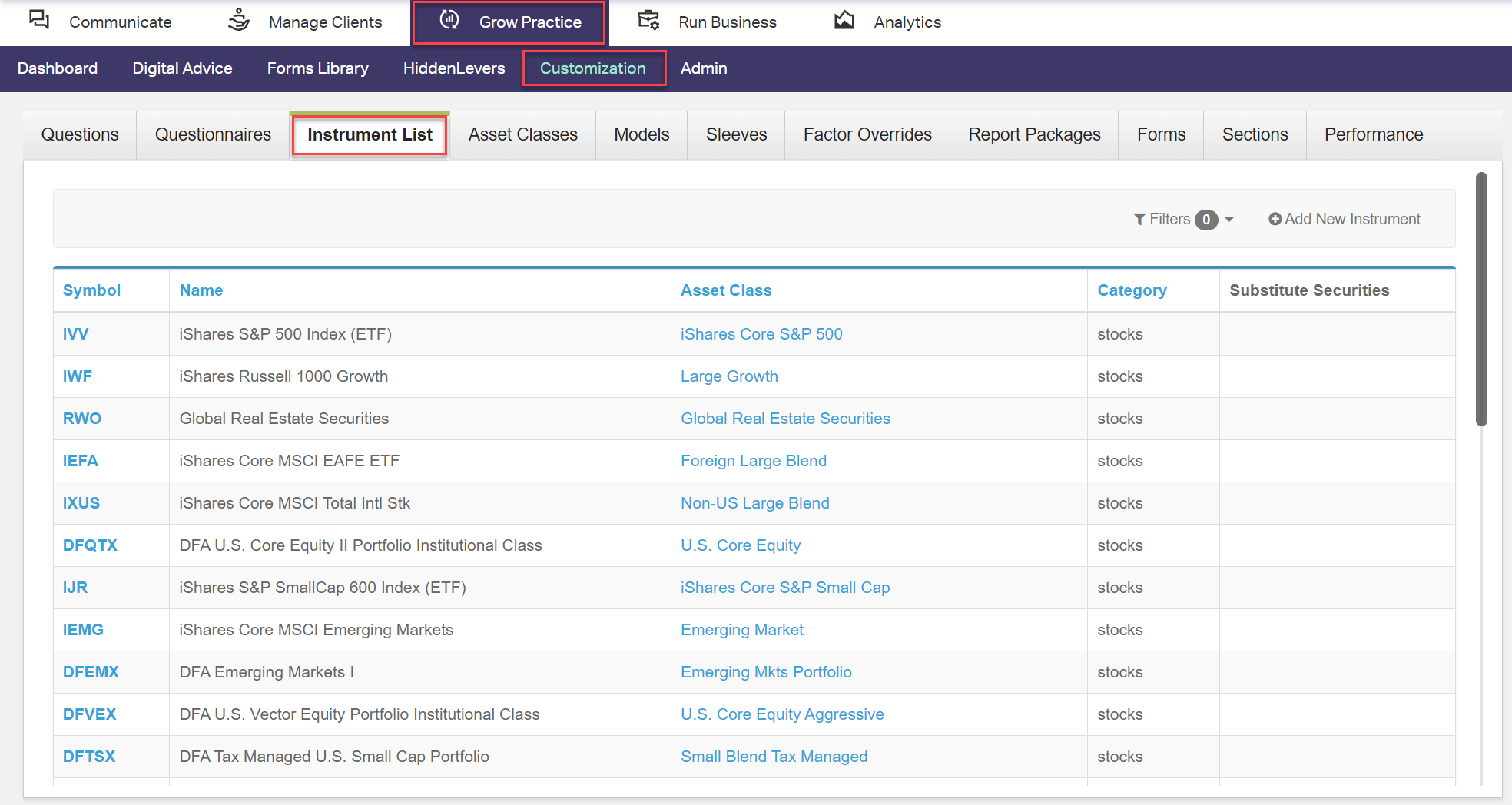Adding and Editing Instruments
Create, edit, and manage Instruments in the Instrument List Page. Instruments are the actual Securities (such as a mutual fund or stock) that make up the building blocks of Models. Instruments are placed into Asset Classes to provide a more generic label (Such as Computer Tech asset class instead of Apple as the Instrument) and a selection of Asset Classes make up a Model.

Adding New Instruments
Instruments must be assigned to Asset Classes. Be sure to create the Asset Classes for your Instruments before creating the Instruments.
Instruments may also be created as part of Adding Asset Classes. Though the interface is different, the data entered is the same.
- Navigate to Grow Practice > Customization > Instrument List.
- Click in the upper right.
- Fill in the necessary content in the available fields:
- Type: Must be set to Security.
- Instrument: Enter the exact Ticker, Symbol, CUSIP, or Company Name. The system searches for matches as you begin typing (minimum 3 characters).
- Accessible for all rep codes: Select whether this Instrument is available for all Portfolio Management Users or only for Users with the specified rep codes below.
- Accessible only with the following rep codes: If the previous option is set to No, use this field to specify which Rep Codes should have access to the instrument.
- Name: Full name of the instrument. This will be visible in the Strategy Selection page and the final IPS document.
- Weight: Weight of the instrument. Unless instructed otherwise, this should always be set to 1 (one).
- Description: Provide a longer description of the Instrument if needed. This will also appear on the Client Portal in the Details section of the Model.
- Priority: Lower numbers indicated higher priority.
- Minimum, $K: Minimum investment, in thousands of dollars, for this instrument. If the minimum amount is not met, the investment will be distributed among the Instruments that do meet the minimum. (Affects Advisor-led account openings only.)
- Ratio, 0-100: The percentage of the assigned Asset Class that this Instrument occupies. If it is the only Instrument in the Asset Class, it will be 100.
- Asset Class: Assign the Instrument to a defined Asset Class from the drop-down.
- Report Holdings with FinMason asset class: Firms can opt to report using asset classes as supplied by FinMason instead of the asset class values set up in AdvisorEngine by selecting the checkbox.
- Substitute Securities: If you are using the SmartLeaf integration, you can define like securities that you want offered in your recommended trades in SmartLeaf when applicable. See Defining Substitute Securities for full details.
- Click to save your Instrument and remain to make further changes. Click to save and close the Instrument. Click to save the Instrument and open another new Instrument form.
Note: Use the spacebar after Symbols with less than 3 characters to complete the entry if necessary. If you are unable to locate the desired instrument, please contact AdvisorEngine Support.
Editing or Deleting Instruments
To edit or delete an Instrument:
- Navigate to Grow Practice > Customization > Instrument List.
- Click the Name or Symbol of an Instrument to open it in edit mode.
- Make any needed changes.
- At the bottom of the form are the three options to continue:
- Update: Save and commit changes but stay in the edit form.
- Update and close: Save and return to the Instrument list.
- Delete: Remove the Instrument from the Portfolio Manager. This cannot be undone.
Related Articles
Adding and Editing Asset Classes
Asset classes give a user-friendly name to Instruments and also allow you to collect your Instruments into groups to be used by your Models. Adding New Asset Classes To add new Asset Classes: Navigate to Grow Practice > Customization > Asset Classes. ...Adding and Editing Models
The Models page allows users to create, edit, and manage models. Adding New Models Navigate to Grow Practice > Customization > Models. Click Actions > + Add New in the upper right. Fill in the necessary content in the available fields: Display Name: ...Adding or Editing Document Folders
AdvisorEngine CRM’s Document Storage system provides access to folders for sorting and storing your Record files. However, the folder system does not function the same as your local computer storage. This article will describe how to work with the ...Adding and Editing Risk Tolerance Questionnaires
Create, edit, and manage questionnaires used for client onboarding in the Questionnaires tab. Prior to creating a Questionnaire, the Questions you want to use must be configured in the Grow Practice > Customization > Questions tab. See Adding and ...Adding and Editing Risk Tolerance Questions
The Grow Practice > Customization > Questions tab provides a list of all possible questions that can be selected to create a Questionnaire used during the client onboarding process. Adding New Questions To create new Questions for use in ...